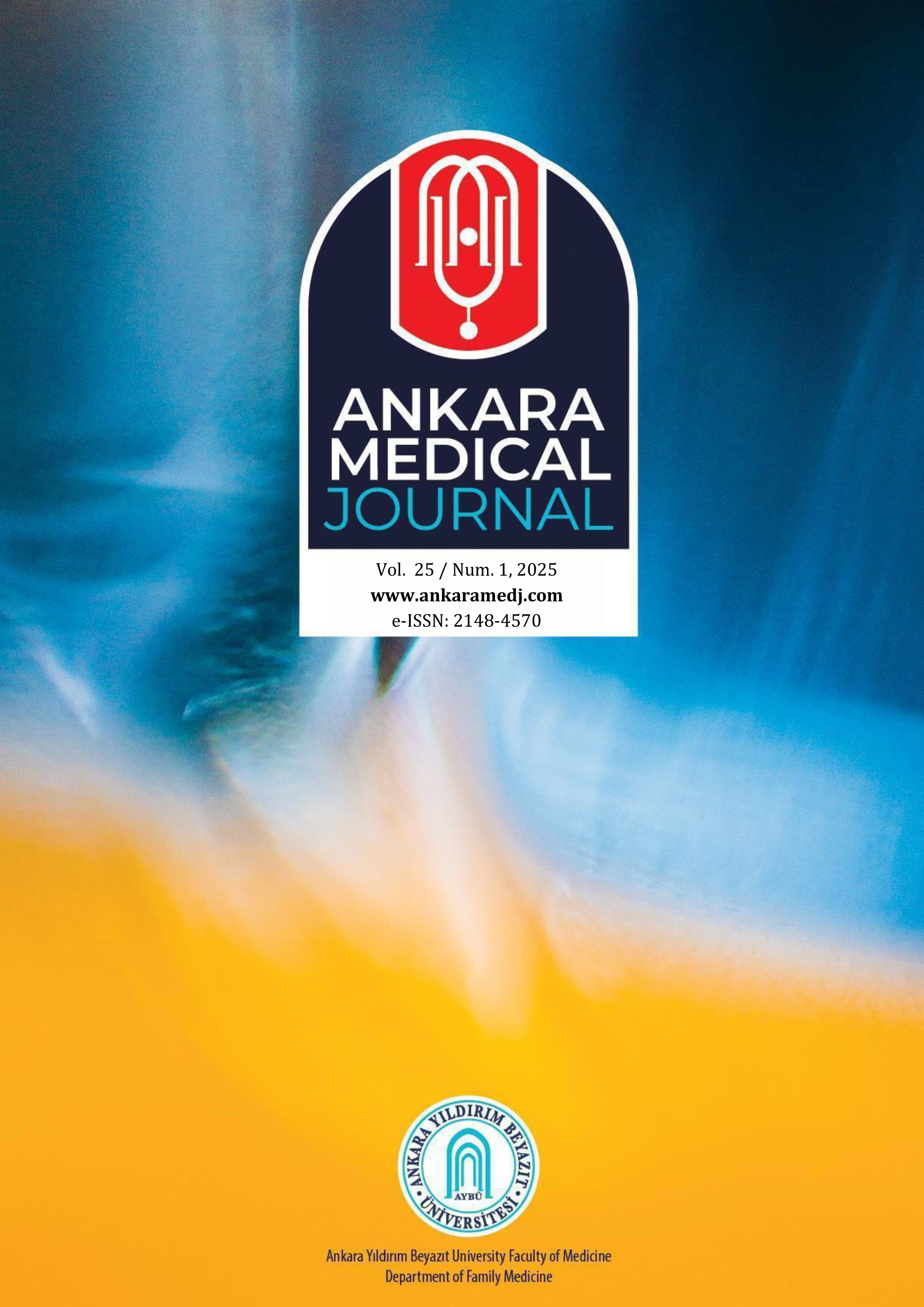E-ISSN: 2148-4570 ISSN:2148-4570
Volume: 25 Issue: 1 - 2025
| ORIGINAL ARTICLE | |
| 1. | Comprehensive Geriatric Assessment for Fall Risk Identification in Nursing Home Residents: Insights and Implications for Medical Practitioners Deniz Mut Sürmeli, Tuğba Turgut, Remzi Bahşi, Hande Selvi Öztorun, Volkan Atmış, Ahmet Yalçın, Sevgi Aras, Murat Varlı doi: 10.5505/amj.2025.36539 Pages 1 - 15 INTRODUCTION: To assess the suitability of the Comprehensive Geriatric Assessment (CGA) in detecting fall risk among nursing home residents, identify its key components associated with high fall risk, and provide practical guidance for medical practitioners. METHODS: This cross-sectional study included adults aged ≥60 residing in a nursing home. All participants underwent a CGA by geriatricians, with the evaluation process taking two months. All participants' medical and fall histories were recorded, including height, weight, calf circumference, muscle strength, and gait speed measurements. The relationship between participants' fall history in the previous year (none vs. ≥1 fall) and the CGA components was assessed. RESULTS: This study includes a total of 104 nursing home residents. 40 individuals (38.5%) had a history of at least one fall and 40% of individuals who fell had fallen two or more times within the last year. In multivariate analysis, malnutrition risk and malnutrition (OR 3.52 [95% CI 1.22-10.12], p= 0.020), muscle strength (OR 5.91 [95% CI 1.02-34.16], p=0.047), and gait speed (OR 3.89 [95% CI 1.13-14.12], p=0.032) were independently associated with the risk of falls, regardless of age, Charlson Comorbidity Index, dependence in activities of daily living, and frailty. DISCUSSION AND CONCLUSION: This study suggests that low grip strength, reduced gait speed, and malnutrition or malnutrition risk are associated with falls among nursing home residents. Instead of the CGA, which requires significant time, assessing these three components of the CGA may be more effective for medical practitioners evaluating fall risk in time-limited outpatient clinics. |
| 2. | Do Caregivers Have an Effect on Extended Hospitalization in Patient-Followed Palliative Care Center? A Study from Türkiye Nuray Yılmaz Çakmak, Rıfat Bozkuş doi: 10.5505/amj.2025.67764 Pages 16 - 26 INTRODUCTION: Since palliative care clinics are clinics that strive to solve the pain caused by the disease as well as other physical and psychological symptoms and social problems as a caregiver burden, the length of stay becomes important in our clinics with high demand from patients. One of the purposes of palliative care centers is to evaluate the patient for discharge. We aimed to investigate whether the length of stay is caused by the caregivers as well as clinical conditions. METHODS: In this study, we retrospectively investigated the days of hospitalization of 915 patients followed in a palliative care center and the factors that prolong hospitalization in patients with extended hospitalization. RESULTS: The average length of stay of the patients was found to be 15.65±11.43 days. Hospitalization longer than 28 days was found in 97(10.60%) patients. The most common reason for extended hospitalization was the reluctance of caregivers to discuss discharge in 47 (48.45%) patients. The second most frequent discharge was delayed in 25 (25.8%) patients due to clinical instability. 23(23.71%). A significant relationship was detected between length of stay and TPN nutrition. A significant relationship was detected between patients with cancer (P: 0.042) and coronary artery disease (P<0.01) on extended stay. DISCUSSION AND CONCLUSION: With the aging of the world population and the improvement of health care services, the need for palliative care is increasing daily. To use resources efficiently, there is a need to optimize the length of stay in palliative care with a multidisciplinary approach. |
| 3. | Assessing the Accuracy, Readability and Understandability of Websites, ChatGPT, Copilot, and Bard Answers on the Radiation during Pregnancy Burcu Mert, Emre Emekli doi: 10.5505/amj.2025.54810 Pages 27 - 39 INTRODUCTION: The study aims to evaluate the accuracy of answers to frequently asked questions (FAQ) about the impact of radiation during pregnancy on websites, ChatGPT, Copilot, and Bard. Secondly, to assess the readability and understandability of answers. METHODS: The answers to these questions were scored in terms of accuracy (completely correct, partially correct, incorrect). The Automated Readability Index (ARI), Flesch Reading Ease (FRE), and Gunning Fog Readability (GFR) scores were calculated. The understandability score was assessed using Patient Education Materials Assessment Tool (PEMAT). RESULTS: The accuracy was calculated as 100% for the websites, 66.67% for ChatGPT, 73.33% for Copilot, and 93.33% for Bard. Readability scores ranking was ChatGPT (ARI=16.15, FRE=24.47, GFR=20.52), Copilot (ARI=14.00, FRE=37.60, GFR=18.27), websites (ARI=13.59, FRE=43.67, GFR=15.56), Bard (ARI=10.92, FRE=48.73, GFR=14.86). ChatGPT's readability was statistically most challenging. PEMAT understandability scores were 79.53% for Bard, below the acceptable limit of 70% for others. DISCUSSION AND CONCLUSION: While the responses from chat tools and websites may be largely accurate, it is observed that they are not suitable for patients in terms of readability and understandability. Internet information sources should be developed, especially to ensure that the content is understandable by a broad readership. |
| 4. | Unnecessary Laboratory Test Repetition In Primary Healthcare Organizations Feyza Erçil Aşcı, Ibrahim Solak, Mehmet Ali Eryılmaz, Mehmet Koc doi: 10.5505/amj.2025.40225 Pages 40 - 52 INTRODUCTION: Laboratory tests are an important tool in reaching the right medical diagnosis and have become an indispensable element for physicians. In this study, we aimed to determine the frequency of unnecessary laboratory test use in primary healthcare institutions, the effect of this situation on health expenditures, and the increase in laboratory test use. METHODS: In our study, the data of 25 specific tests studied between 2016 and 2019 in Konya Public Health Laboratory, which serves primary healthcare institutions, were examined. The compliance of these tests with the minimum test repetition interval was retrospectively screened, and the frequency of unnecessary test requests was determined. RESULTS: A total of 15,425,622 laboratory tests were evaluated in the study. Of these, 11,541,394 (74.8%) were performed on women, and 13,289,770 (86.1%) were conducted on patients under 65 years of age. It was determined that 956,112 (6.2%) of the evaluated tests were unnecessary repetitions. Unnecessary test repetitions were found to be significantly higher in females compared to males (p<0.001) and in those above 65 years of age compared to those under 65 years of age (p<0.001). The 4-year cost of unnecessary laboratory tests was determined to be ₺5,479,093.37. It was also found that the use of laboratory tests increased by 123.6% over the 4-year evaluation period. DISCUSSION AND CONCLUSION: The use of laboratory tests in primary care is increasing, and unnecessary repeated tests harm the country's economy. To reduce costs and provide better health care, it is necessary to use laboratory tests wisely and to make effective interventions for this purpose. |
| 5. | An Examination of Pediatric Patients Presenting to the Emergency Department Due to Domestic Accidents During the Pandemic Period Nurullah Ishak Işık, Mehmet Ergin, Kadir Yenal, Ezgi Şeker Eren doi: 10.5505/amj.2025.86244 Pages 53 - 66 INTRODUCTION: This study aims to examine pediatric emergency department visits due to domestic accidents during the COVID-19 pandemic. It focuses on analyzing the clinical features, underlying causes, and parental attitudes during increased home confinement. METHODS: This prospective observational study investigates the impact of pandemic-related lockdowns on children and parents, specifically their association with domestic accidents. Patients under 18 years old, who present with domestic accidents and with parental consent, were included. Data collected included demographics, trauma mechanisms, injury locations, and emergency department outcomes. After which discharge, parents were surveyed about their educational and employment status, behavioral changes in their children, and perceptions of accident rates during the pandemic. RESULTS: The median age of patients was 5 years (1-11), with 34.5% (n=20) being female. Falls were the most common cause of trauma (79.3%, n=46), with head injuries occurring in 44.8% (n=26). The majority (91.4%, n=53) attributed the accidents to carelessness. Additionally, 60.3% (n=35) reported behavioral changes in their children due to staying at home, and 74.1% (n=15) believed domestic accidents increased during the pandemic. Behavioral changes were particularly notable among school-age children (p<0.001). Families with sibling care, lower parental education levels, and higher hospital admission rates had increased behavioral changes (p=0.020, p=0.008, p<0.001, p=0.011). DISCUSSION AND CONCLUSION: The quarantine period during the pandemic significantly impacted both parents and children, increasing the risk of domestic accidents. The study highlights that caregiver awareness and education are crucial in preventing such incidents. Regular parental training at community health centers can reduce accident frequency and improve outcomes. |
| 6. | The Impact of Digital Health Literacy on Healthy Lifestyle Behaviors among Adults: The Case of Ankara Keziban Avcı doi: 10.5505/amj.2025.02259 Pages 67 - 79 INTRODUCTION: This study examines the influence of digital health literacy on the adoption of healthy lifestyle behaviours among adults residing in the city of Ankara. METHODS: A cross-sectional web-based survey was conducted among 414 adults aged 1864 in Ankara, utilising validated scales for digital health literacy and healthy lifestyle behaviours. The data were analyzed for socio-demographic patterns, scale reliability, and regression to identify the relationships between digital health literacy and healthy lifestyle behaviours. RESULTS: The mean score for the Healthy Lifestyle Behaviour Scale was 85.17 (±11.54), with the highest scores observed for the 'Sleep' item and the lowest for the 'Personal Health Responsibility-II' item. The mean score for the Digital Health Literacy Scale was 2.86 (±0.40), with the highest score for "Privacy Protection" and the lowest for "Credibility." The regression analysis revealed a positive and statistically significant relationship between digital health literacy and healthy lifestyle behaviours. In particular, the subdimensions "Information Seeking" (β = 0.150, p = 0.014) and "Privacy Protection" (β = 0.123, p = 0.019) had a significant impact. DISCUSSION AND CONCLUSION: The results of this study indicate that individuals with higher levels of digital health literacy are more likely to adopt healthy lifestyle behaviours. Enhancing digital health literacy can empower individuals to adopt healthier habits, access reliable health information and effectively utilise digital health services, thereby improving public health outcomes. |
| 7. | Assessment of the Relationship Between Sexual Satisfaction and Diabetes Self-Management in Adults with Diabetes and the Factors Influencing This Relationship Sibel Peksoy Kaya, Tugba Bilgehan doi: 10.5505/amj.2025.05695 Pages 80 - 95 INTRODUCTION: This study aimed to evaluate the relationship between sexual satisfaction and diabetes self-management among individuals diagnosed with diabetes mellitus (DM), as well as the factors influencing this relationship. METHODS: This descriptive and correlational study was conducted with 140 individuals with DM in a public hospital in Ankara, Turkey. Data were collected using the Individual Information Form, New Sexual Satisfaction Scale (NSSS), and Diabetes Self-Management Questionnaire (DSMQ). RESULTS: Participants' mean NSSS score was 60.18±17.97, and their mean DSMQ score was 5.65±1.71. Higher NSSS scores were observed in participants who were satisfied with their partner relationship, reported no changes in their sexual life compared to before their DM diagnosis, consumed alcohol, and whose partners had a university-level education or higher (p < 0.05). A positive correlation was found between the total scores and subdimensions of NSSS and DSMQ (p < 0.05). Regression analysis indicated that fasting blood glucose (FBG) (Beta= -0.22, p < 0.001), alcohol consumption (Beta= -6.79, p = 0.022), and satisfaction with the partner relationship (Not satisfied, Beta= -18.00) had significant effects on NSSS scores (p < 0.05). Additionally, DSMQ had a positive effect on NSSS (Beta= 1.47; p = 0.05). DISCUSSION AND CONCLUSION: Sexual satisfaction in individuals with DM is influenced by diabetes self-management. Partner relationship satisfaction and FBG are critical determinants of sexual satisfaction. Therefore, integrating sexual health and glycemic control into education and counseling services is essential for individuals with DM. |
| REVIEW | |
| 8. | Digital Transformation of Clinical Education through Artificial Intelligence: A Strengths, Weaknesses, Opportunities, and Threats (SWOT) Analysis Seyma Handan Akyon, Fatih Cagatay Akyon doi: 10.5505/amj.2025.63373 Pages 96 - 118 This review article examines the impact of Artificial Intelligence (AI) on the digital transformation of clinical education through a comprehensive SWOT (strengths, weaknesses, opportunities, and threats) analysis. AI offers several strengths, including innovative learning strategies through simulations and virtual patients, personalized learning paths, advanced clinical training, and enhanced communication skills. However, AI faces weaknesses such as a lack of transparency, potential for misinformation, limited curriculum integration, and access inequality. Opportunities include managing information overload, providing real-time feedback, supporting multiple languages, and generating clinical scenarios. Threats include misinformation and bias, overdependence on AI, privacy concerns, lack of human interaction, and access inequality. Addressing these challenges is critical to fully realize AI's potential in medical education. |
| LETTER TO EDITOR | |
| 9. | What Can Research on Earthquake Survivors Staying in Remote Areas Teach Us? The Impact of Relocation After The Earthquake on Mental Health Arda Bağcaz doi: 10.5505/amj.2025.71235 Pages 119 - 121 Abstract | |






